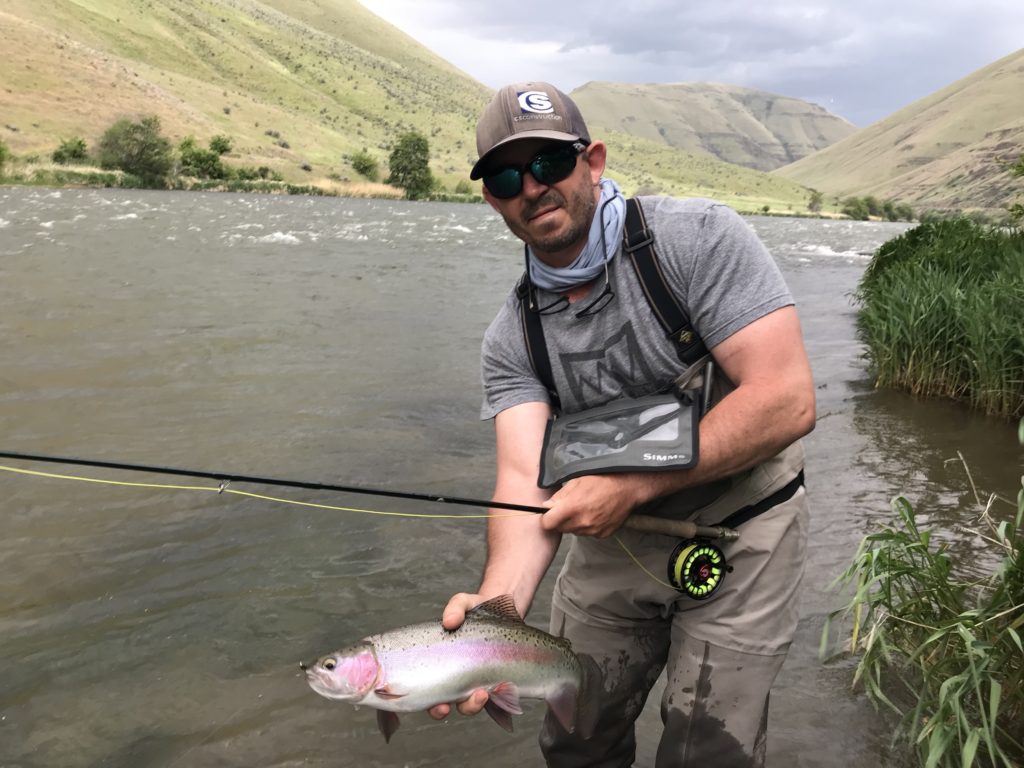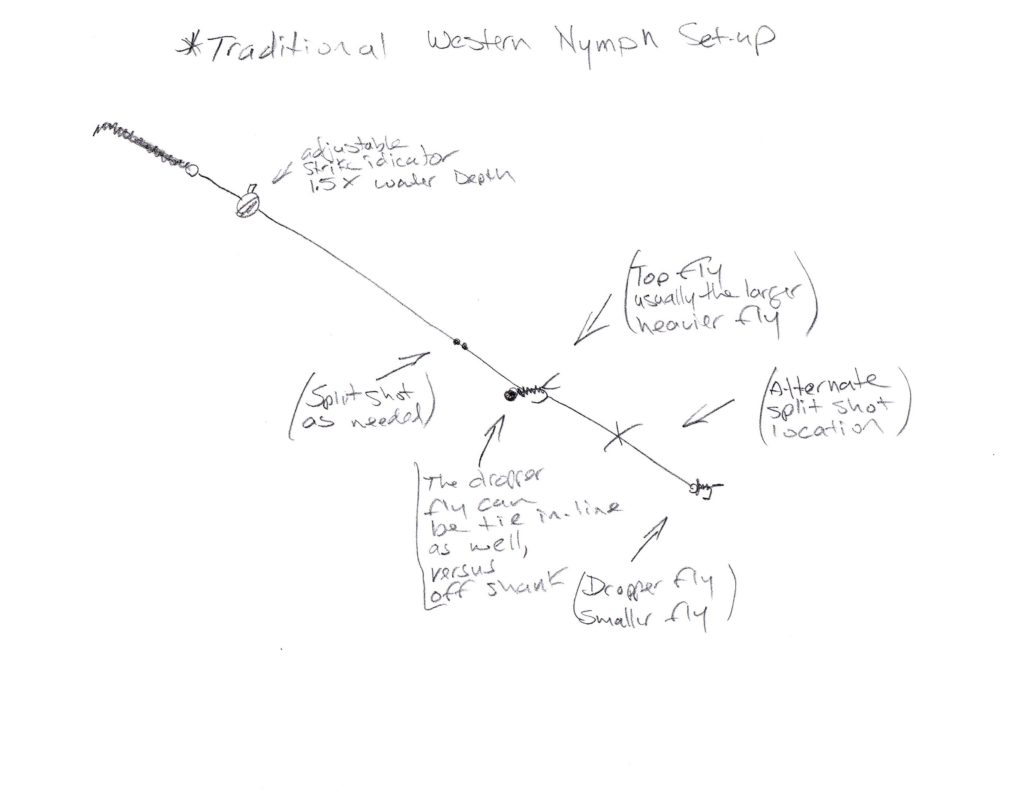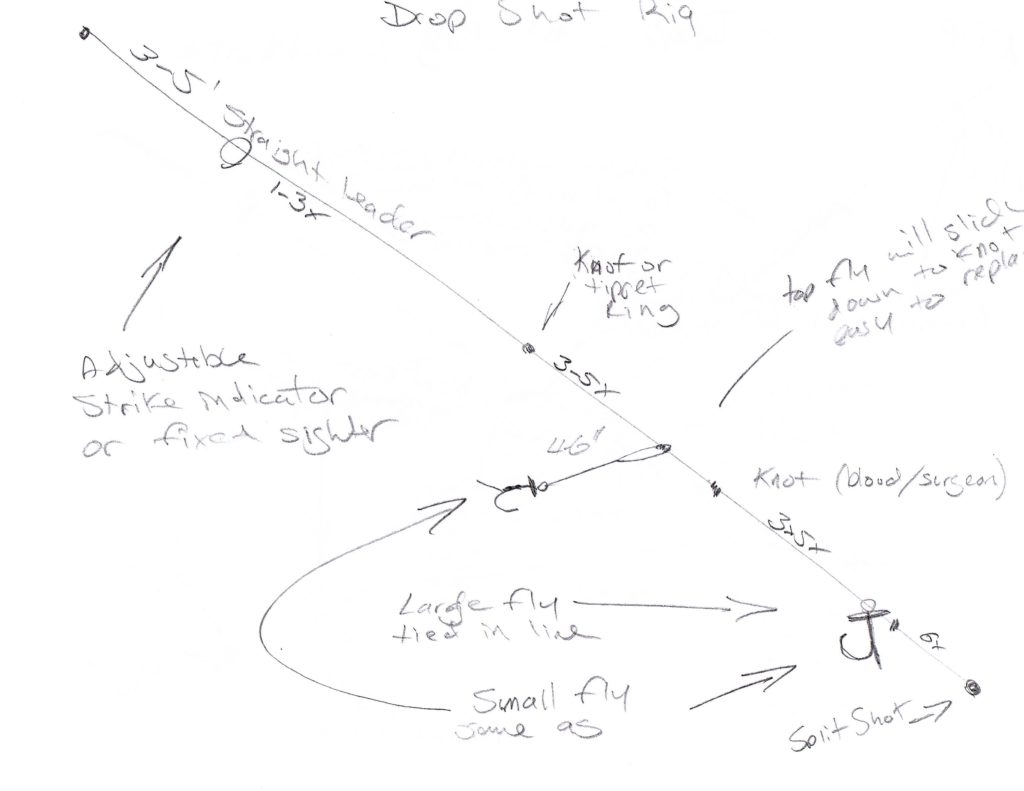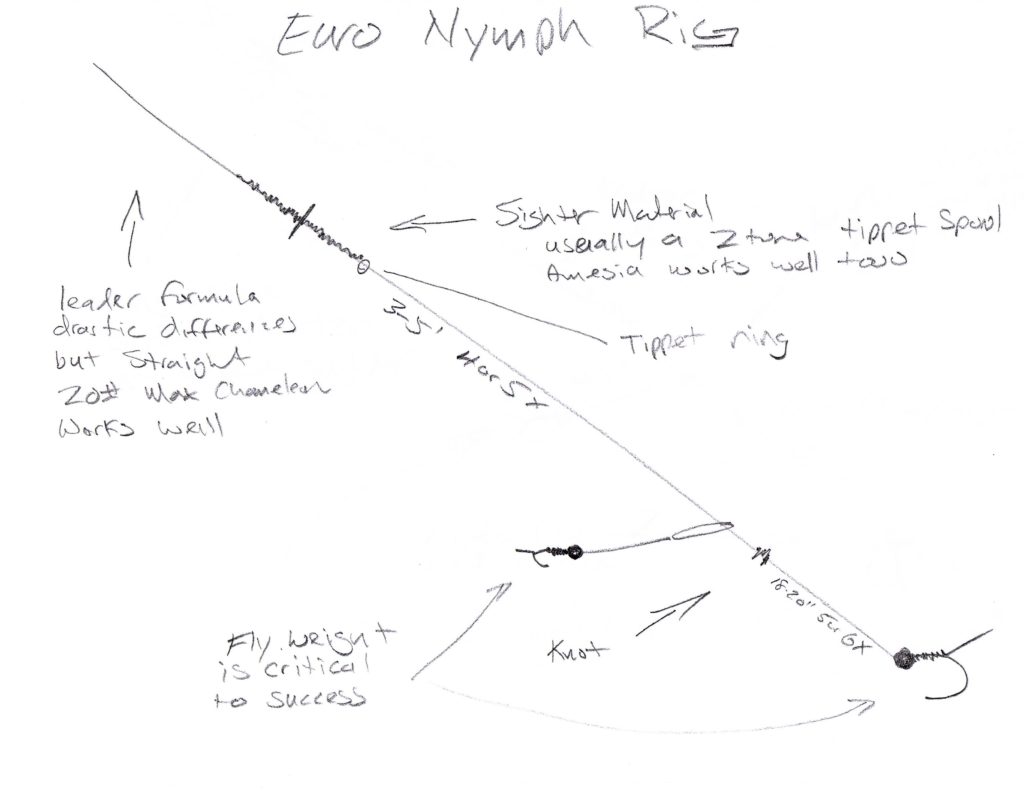
Why nymph fish at all? The truth is the overwhelming majority of trout feeding behavior happens below the water’s surface. In fact most feeding activity happens around twelve inches off the river bottom. The answer is to catch fish when they are not feeding on the surface, ie, most of the time. Let’s be honest, if you fish western rivers for trout you nymph fish a lot. Now I know nymph fishing isn’t for everyone, this article is for everyone else. Recently the European style of nymphing has gained in popularity and here’s why.
Before we step into the whole “euro” nymph deal, let’s just back-up a bit and talk about standard nymph rigs. This is the standard western nymph rig; it’s worked for a long time. This system is out of date, and if you are still using it, you are losing too many flies, spending too much time re-rigging, and most importantly, not making good drift and not seeing most strikes. I know this is offensive, I though the same thing…at first. The first problem with this set up is the strike indicator, often large and cumbersome, designed to float heavy flies and split shots. Here’s the problem; this thing is a mess from the get-go. The bobber is big – it creates drag because water on the surface is faster than water near the bottom (where we want our flies). So, even though we are now fishing heavy rods and heavy lines so we can chuck massive payloads in order to get our flies down on bottom, the strike indicator is pulling our flies off the bottom. How do we fix this? For starters we cast faster upstream, stack mend the bobber above the flies and and continue mending. The weight sinks fast and creates a hinge point and hopefully the flies follow the flies to the bottom, but mostly we create slack. There is no doubt our flies get eaten and we catch some fish doing this but it’s inefficient. The flies are rarely in the strike zone and on a tight line, that is why this is the least effective style of nymph fishing. This style of fishing is best suited to boat fishing and it sucks at that as well.

Drop shot nymphing; Simply put, drop shot nymphing is just that. See the diagram above, “standard”. Typically the spilt shot are placed above the flies in a standard nymph rig. In a drop shot rig the weight is dropped below the flies. Often times anglers will high stick drift a drop shot rig with out a bobber type strike indicator. This is very simian to european nymphing but not quite. This is a very effective style of nymph fishing for trout. The current on the surface even when using a strike indicator is negated by the lead dragging and bouncing off the bottom, creating the angle needed to put the flies in the strike zone. Frankly speaking, short line high sticking with this method is effective but I like it best for fishing indicators at distance and for extended drifts. Anglers use very few flies fishing this technique due to the drop shot being on the botton and the flies above.

European Nymphing is a catch all term for Czech Nymphing, every european country has basically adapted their own style to the Czech style, it’s easier to just call it all “euro nymphing”. Euro nymphing is done with a longer lighter rod and a very long leader, a sighter, and up to three weighted flies and no split shot. For people familiar with “drift fishing” terminal tackle, this technique is similar.

The Euro Rig is extremely simple and effective for catching trout. Typically the fly line is very thin. The leaders are long and thin in diameter. Flies are weighted in accordance to the water the angler is fishing. Fly patterns are simple, very simple, presentation always trumps the pattern. The ideas is that the flies tumble along the bottom on a thigh line where the trout live. Strike detection is via a “sighter”, usually chartreuse and fluorescent orange in color with a blood knot at the junction and the knot tags in tact. Straight 5x for the length of the leader is typical so 10 to 10.5′ 3 weights is the norm. The only weakness to this technique is at distance. The farther away this rig is from the rod tip the more “sag” is created between the leader and the rod tip, thereby dragging the flies. Sag can be defeated with lighter lines and tippets two things which make casting harder and harder.
So lets talk about casting. Traditional nymphing rods lend themselves the best to overhead casting as well as roll casting. Typically 5-7 weight rods, way weight forward nymphing lines and flies in line heavier ones up top make this the go to set up for casting at distance. Drop shot its are built to fish not to cast but the way weight forward fly lines and the heavier rods can still be you friend and if you’r careful you can still cast this rig. Heavy emphasis on mending this without moving the strike indicator it needs to drag the flies. The “Euro Nymph” rig does not cast, it’s not built to cast it’s built to cut the resistance of the upper current speed. Fishing the Euro Rig is best done from 20-30′ max, the closer the better. The flies are extremely heavy and the tippet is extremely thin so tension casting is best. The flies can be cast further by shooting some line, the weight of the flies can carry the cast a long ways but remember with the rod tip up at distance you create sag, reducing your effectiveness dramatically.
Tackle. There are several Eurpean Style Nymphing rods available today, typically 10-11′, 2-4 weight rods. A soft tip is required to protect light tippets and to cast light rigs. Fly lines are very thin with very small to no loops at the end. The ends go through the guides while fighting fish and remember we are typically fishing 5x. Very small 3 or 4 turn nail knots are recommended. 20,15,12# Maxima Chameleon, a sighter material too tone, or amnesia if you have it or can find it, tippet rings or micro swivels. The reel needs to be heavy. Holding a rod tip up all day is hard on the shoulder muscles, the easier to keep that rod tip up the better. The flies make this style of fishing so you will need to tie your own or go to a shop than carries them.
Flies. The bottom fly is the “point” fly or the anchor fly. The point fly is normally the heaviest fly. The dropper fly is 16-20″above the point fly (see diagram). I like a variety of sizes of tungsten beachhead flies wrapped with lead for this style of fishing. Like I said before, presentation trumps pattern. Anglers need a varietybof weighted flies to fish a variety of water speeds ad depths.
Dirty Euro Nymphing. In some instances, say you’ve lost all you’re heavy flies on the bottom but fishing is good and you wanna keep going. Don’t be afraid to rig your euro nymph rod with a drop shot rig. That’s right, try a drop shot rig on your ESN rod.
I started nymph fishing in 1992, and have been fishing a long time since. Playing with straight leaders, heavier flies, better strike indicators, etc can’t fix the reel problem, fighting two speeds of current and keeping a tight line. Euro nymphing, or modern nymphing techniques are becoming mainstream and for good reason, they minimize current speeds and keep the flies in the bite zone on a tight line making strikes not only easy to detect…you can actually feel them most of the time. If you enjoy catching fish and you enjoy nymphing, it’s time to modernize.
If you would like to learn more we offer on the water modern nymphing instruction as well as guided trips for trout on tyler lower Deschutes year round.
To book a trip or schedule instruction please contact me;
Sam Sickles, samsickles@gmail.com., 541-400-0855





